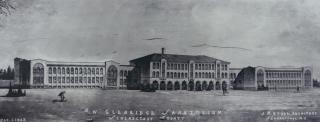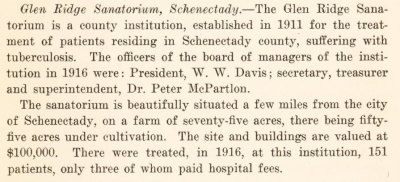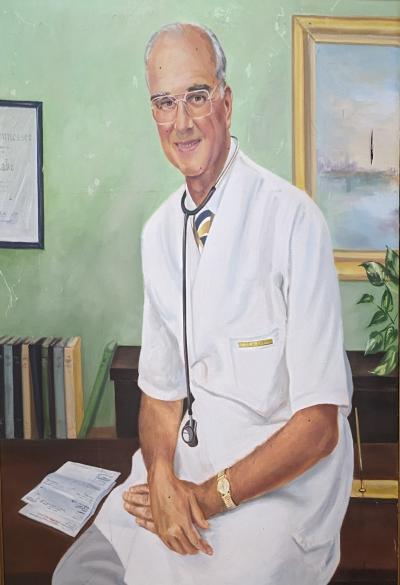The Glenridge Sanatorium

At the turn of the 20th century in America, Tuberculosis killed 194 people per 100,000.1 Formerly known as "consumption", this disease was long believed to be hereditary and incurable. In the mid-1800 when scientists began to theorize that it was caused by an infectious agent.2 In 1854, the first effective was discovered when botanist Hermann Brehmer opened the world's first sanatorium in Gorbersdorf, a small town in the mountains of modern-day southwestern Poland. In his doctoral dissertation, "Tuberculosis is a curable disease", Brehmer detailed the spontaneous remission of his tuberculosis while visiting the Himalayas.3 Inspired by his own rehabilitation, Brehmer believed that fresh mountain air and good nutrition could restore tuberculosis patients to good health.
In the late 19th century, a young physician named Robert Livingston Trudeau experienced the benefits of resting in the mountain air while on retreat in the Adirondack Mountains at Saranac Lake. The remission of his tuberculosis encouraged Trudeau to champion the sanatorium movement in the United States. His success was realized when Governor Theodore Roosevelt signed public health legislation that allowed for the development of sanatoriums in each county of the state. Soon thereafter, the Schenectady County Sanatorium was opened by the American Red Cross. The first sanatorium was a seasonal camp consisting of a tent village constructed on the outskirts of the city. A more permanent sanatorium was built in 1909 in Niskayuna, but this burnt down several years later.
 In 1912, a new tuberculosis hospital was established by Schenectady County on the Lampe farm on Glenridge Road in the Town of Glenville. Dr. Peter McPartlon served as the first medical director of the Glenridge Sanatorium, and held that position until is retirement in 1933. The first iteration of the sanatorium on this site consisted of a series of small wooden cottages. The image on the right is from Dr. James Walsh's History of Medicine in New York, published in 1919, and describes the sanatorium as it existed at that time.5
In 1912, a new tuberculosis hospital was established by Schenectady County on the Lampe farm on Glenridge Road in the Town of Glenville. Dr. Peter McPartlon served as the first medical director of the Glenridge Sanatorium, and held that position until is retirement in 1933. The first iteration of the sanatorium on this site consisted of a series of small wooden cottages. The image on the right is from Dr. James Walsh's History of Medicine in New York, published in 1919, and describes the sanatorium as it existed at that time.5
 In 1927, the cottages were replaced by a beautiful, more permanent Spanish Eclectic-style brick building. Unusual for the area, the new sanatorium building was designed by architect J. M. Ryder, who was employed by General Electric in Schenectady.
In 1927, the cottages were replaced by a beautiful, more permanent Spanish Eclectic-style brick building. Unusual for the area, the new sanatorium building was designed by architect J. M. Ryder, who was employed by General Electric in Schenectady.
It was here in 1934 that the pioneering Dr. James Morgan Blake would build his renowned practice and usher in modern tuberculosis treatment for patients in Schenectady County. Blake, who had been cured of severe tuberculosis in a sanatorium after attending medical school at the University of Tennessee, was a major proponent of open-air treatment for tuberculosis. In an essay called, "On Sleeping (?) On a Sanatorium Porch In Winter" which appeared in a 1939 issue of the patient-published Glen San journal, the unnamed author describes building a "wigwam" of pillows and blankets to keep them warm while sleeping outside in the cold winter air. The challenge that faced patients, who had deftly constructed their cocoon to shield them against the elements while sleeping on the porch, was securing themselves into the tightly tucked in blankets afterwards. "Experienced members bound to the top of the bed with one great effort and proceed to wriggle in, simulating an eel for a moment."6
As new treatments were introduced for tuberculosis, including streptomycin and isoniazid, the need to hospitalize tuberculosis patients was greatly reduced. The Glenridge Sanatorium continued to treat only tuberculosis patients until 1957, when the state granted them a license to treat other patients with respiratory ailments, like chronic bronchitis, lung cancer, asthma and pulmonary fibrosis. Dr. Blake was a renowned bronchoscopist, and he was the first to use a fiberoptic bronchoscope in Schenectady.7 In the 1960s, under Blake's leadership, Glenridge Hospital became the first in the county to care for critically ill patients.8 In 1968, the sanatorium became a general hospital. As technology improved and the costs of running a hospital increased in the 1970s, there was less of a need for a general hospital in Glenville. The hospital closed its doors in 1978. In 1983, the property was purchased by Liberty Behavioral Management Group. They opened a residential drug treatment facility, Conifer Park, which is still in operation today.
Our town history collection contains one issue of a newsletter/journal, the Glen San, written by the patients of Glenridge Sanatorium in 1939. It contains drawings, essays, articles and poetry, and offers a unique look into life at the sanatorium for tuberculosis patients at that time. Click here to read it.
References:
1. Snider, G L. “Tuberculosis then and now: a personal perspective on the last 50 years.” Annals of internal medicine vol. 126,3 (1997): 237-43. https://doi.org/10.7326/0003-4819-126-3-199702010-00011
2. Wikipedia contributors. "History of tuberculosis." Wikipedia, The Free Encyclopedia. Wikipedia, The Free Encyclopedia, 24 Feb. 2024. Web. 30 Mar. 2024. https://en.wikipedia.org/wiki/History_of_tuberculosis
3. Wikipedia contributors. "Hermann Brehmer." Wikipedia, The Free Encyclopedia. Wikipedia, The Free Encyclopedia, 31 Aug. 2023. Web. 30 Mar. 2024. https://en.wikipedia.org/wiki/Hermann_Brehmer
4. Gullott, R.F. and Hayford, F.C. "Glenridge Hospital" in Strosberg and Snitkoff's Two Centuries: Caring for a Community: The Medical Society of the County of Schenectady Bicentennial, 1810-2010. Schenectady, NY: Medical Society of the Community of Schenectady, 2010.
5. Walsh, J. J.. History of Medicine in New York: Three Centuries of Medical Progress, Volume 1. National Americana Society, 1919.
6. Stark, V. Ed. "On Sleeping (?) on a Sanatorium Porch in Winter." The Glen San vol. 5, 7 (1939): 3-4.
7. Gullott and Hayford, 2010.
8. Gullott and Hayford, 2010.

